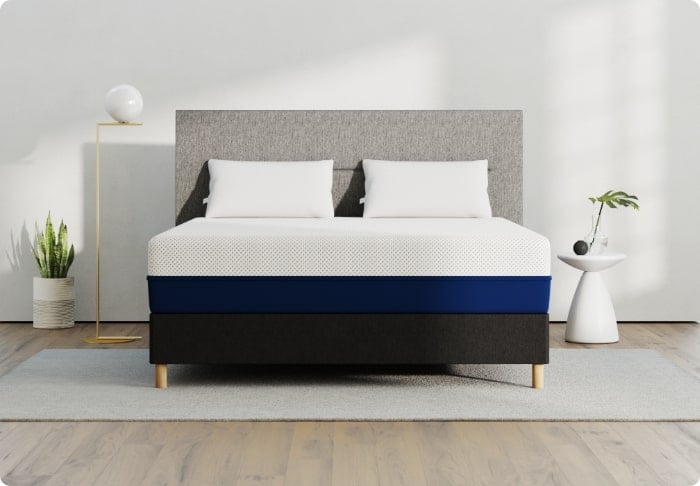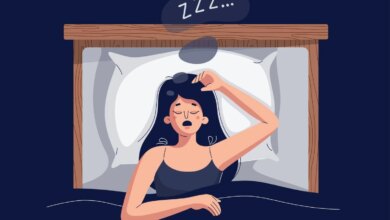Just Breathe: How the 4-7-8 Method Could Help You Sleep

Key Takeaways
- The technique is simple but specific: Inhale for 4 counts, hold for 7 counts, exhale with a whooshing sound for 8 counts. The precise pattern and whooshing exhale are crucial for activating your parasympathetic nervous system and triggering relaxation.
- Start slowly and practice safely: Begin with only 4 cycles (never more than 8), practice regularly during the day when not trying to sleep, and avoid the technique if you’re pregnant or have heart/breathing conditions without medical approval.
- It’s a trainable skill, not instant magic: While some people feel effects immediately, most need 1-2 weeks of consistent daily practice for the technique to become reliably effective. Your nervous system needs time to learn this new relaxation response pattern.
You toss and turn in bed, watching the clock tick past midnight while your mind races with tomorrow’s worries. Millions of people face this same struggle every night, lying awake despite feeling exhausted.
Traditional advice like counting sheep or drinking warm milk often falls short when stress and anxiety keep your brain buzzing. The good news is that scientists have found a simple breathing technique that can trigger your body’s natural relaxation response in just minutes.
This method, called 4-7-8 breathing, uses the power of controlled breathing to calm your nervous system and prepare your body for sleep. Medical experts have popularized this ancient technique, which combines centuries-old wisdom with modern understanding of how our bodies respond to stress.
Best of all, you can learn this method in under five minutes and use it anywhere without any special equipment. Keep reading to learn exactly how the 4-7-8 method works and how to use it safely for better sleep.
What Is the 4-7-8 Method?
This simple technique gets its name from three specific numbers that control how long you inhale, hold your breath, and exhale. The method combines ancient breathing wisdom with modern sleep science to create a powerful tool for relaxation.
The precise pattern is inhaling for 4 counts, holding your breath for 7 counts, and exhaling for 8 counts. These specific numbers create the right rhythm to slow down your nervous system and trigger your body’s natural sleep response.
The longer exhale is the key part of this technique because it activates your parasympathetic nervous system, which controls rest and recovery functions. You repeat this cycle up to four times when starting out, though experienced users can safely do up to eight cycles.
The counting gives your mind something simple to focus on, which helps stop racing thoughts that keep you awake.
What the Method Promises
The 4-7-8 breathing technique promises to help you fall asleep in just a few minutes by working with your body’s natural relaxation response. This method uses a specific pattern of inhaling, holding, and exhaling that forces your nervous system to slow down and shift into sleep mode.
Users often report feeling drowsy after just one or two cycles, especially when they practice the technique regularly. The technique works by reducing anxiety, lowering your heart rate, and releasing physical tension that keeps you awake.
While individual results vary, many people find this method more effective than traditional sleep aids because it addresses the nervous system directly rather than masking symptoms.
Ancient Roots
The 4-7-8 pattern specifically draws from a
pranayama
technique
that focuses on lengthening the exhale to release tension and stress.
Ancient practitioners understood that breath control could change their mental and physical state long before modern science explained how it works. These time-tested methods prove that simple breathing techniques can be just as powerful as modern sleep aids when used correctly.
How Medical Experts Made it Popular
Integrative medicine specialists brought this ancient breathing technique into mainstream healthcare by explaining the science behind why it works so effectively.
Medical professionals recognized that this simple method could help patients reduce anxiety and improve sleep without relying on medications.
Healthcare providers began recommending the technique because it’s safe, free, and gives people an active tool to manage their own sleep problems.
The method gained popularity through medical conferences, wellness programs, and sleep clinics where professionals saw real results with their patients.
Today, many doctors, therapists, and sleep specialists teach this technique as part of comprehensive sleep hygiene programs.
When Counting Sheep Does Not Work
Up to 70 million Americans struggle with sleep problems, turning bedtime into a source of anxiety rather than rest. Your brain stays active long after your head hits the pillow, replaying conversations, planning tomorrow’s tasks, or worrying about things beyond your control.
Traditional sleep remedies often fail when your mind refuses to quiet down and your body stays tense from daily stress. Many people find themselves stuck in a cycle where worry about not sleeping actually makes falling asleep even harder.
Sleep medications can create dependency and leave you feeling groggy the next day, while many natural remedies simply don’t address the root cause of sleeplessness.
The problem often stems from an overactive nervous system that doesn’t know how to shift from the stress of daily life into a calm, restful state.
This creates a frustrating pattern where the harder you try to fall asleep, the more elusive sleep becomes.
Why Breathing Techniques Offer Hope
Controlled breathing works directly with your body’s natural systems to trigger relaxation, unlike other methods that only address symptoms. When you change how you breathe, you send immediate signals to your nervous system that it’s time to calm down and prepare for rest.
Your breath connects directly to your heart rate, blood pressure, and stress hormone levels, giving you real control over your body’s sleep preparation process. Breathing techniques require no medications, special equipment, or perfect conditions – you can use them anywhere, anytime you need to relax.
Research shows that specific breathing patterns can activate your parasympathetic nervous system, which naturally promotes sleep and recovery.
The Science of It
Your body has simple systems that control sleep and wakefulness. Understanding these systems shows you why changing your breathing can help you fall asleep faster.
Fights Stress Hormones
Your body makes chemicals called cortisol and adrenaline when you feel stressed during the day. These chemicals stay in your blood for hours after stressful events, keeping your brain awake and your muscles tight.
Your body thinks it needs to stay alert for danger, even when you just want to sleep. These stress chemicals tell your brain to keep watching for problems instead of resting. You need to lower these chemical levels before your body will let you fall asleep naturally.
Calms Fight-or-Flight Response
Your nervous system turns on “alert mode” when it senses stress or danger. This makes your heart beat faster, raises your blood pressure, and sharpens your thinking.
All things that keep you awake. Your body reacts the same way to work stress as it does to real emergencies.
This alert system helped keep people safe long ago, but now it keeps you awake worrying about everyday problems. Your body stays in alert mode until it gets clear signals that everything is safe and it can relax.
Triggers Relaxation
Special breathing patterns for sleep send messages directly to the part of your brain that controls relaxation. When you breathe out longer than you breathe in, you turn on your body’s “calm down” system.
This works faster than trying to stop worrying because it talks directly to your body’s control center. Your breathing connects your mind to body systems you normally can’t control. The 4-7-8 pattern uses the best timing to turn on your relaxation system as quickly as possible.
Lowers Heart Rate and Blood Pressure
The long exhale in 4-7-8 breathing makes your heart slow down and your blood pressure drop. Your heartbeat becomes steady and calm instead of fast and jumpy from stress. Your blood vessels relax, which lowers your blood pressure throughout your body.
These changes tell every part of your body that it’s time to get ready for sleep. Within just a few breaths, your body starts creating the perfect conditions for falling asleep naturally.
Critical Points
This breathing technique is safe for most people, but you need to know important safety rules before you start. Following these guidelines helps you get the best results while avoiding problems.
Why Beginners Should Start With 4 Cycles (Not More)
Your body needs time to get used to this new breathing pattern, and doing too many cycles too soon can make you dizzy or lightheaded. Starting with four cycles lets your nervous system adjust gradually without overwhelming your body’s responses.
Some people feel powerful relaxation effects right away, which can be surprising if you’re not prepared for them. Beginners who do more than four cycles often feel uncomfortable or even anxious instead of relaxed.
Stick to four cycles for at least two weeks before adding more! This gives your body time to learn the technique safely.
When to Avoid This Technique
Don’t use this breathing method if you’re pregnant, have heart problems, or take medications that affect your breathing or blood pressure. People with severe anxiety or panic disorders should talk to a doctor before trying this technique because it can sometimes trigger unexpected reactions.
If you have asthma, breathing problems, or take blood pressure medications, check with your healthcare provider first. Anyone who feels chest pain, severe dizziness, or trouble breathing should stop immediately and see a doctor.
This technique changes your heart rate and blood pressure, so people with serious health conditions need medical approval first.
The Importance of the Whooshing Exhale Sound
The whooshing sound isn’t just noise! It helps you control the speed and completeness of your exhale, which is the most important part of the technique. This sound ensures you’re breathing out long enough and completely enough to trigger your body’s relaxation response.
Making the sound also helps you focus on the breathing instead of letting your mind wander to other thoughts. Without the whooshing exhale, you might breathe out too quickly or not empty your lungs completely.
The sound might feel silly at first, but it’s a key part of making the technique work properly.
Why Regular Practice Matters Even When Not Sleepy
Practicing this technique during the day when you’re not trying to sleep helps train your nervous system to respond faster when you really need it. Your body learns to recognize the breathing pattern and starts the relaxation response more quickly each time you practice.
Regular practice also helps you get comfortable with the technique so you can do it correctly when you’re stressed or anxious. Think of it like learning to ride a bike! The more you practice, the more automatic it becomes.
People who only use the technique when they can’t sleep often don’t get the full benefits because their body hasn’t learned the pattern yet.
Signs You’re Doing It Wrong
If you feel dizzy, anxious, or more awake after doing the technique, you’re probably breathing too forcefully or doing too many cycles. Headaches, chest tightness, or feeling short of breath are signs that you need to slow down or breathe more gently.
You shouldn’t feel strain or discomfort during any part of the breathing cycle – it should feel natural and calming. If you can’t make the whooshing sound properly, check your tongue placement and make sure you’re exhaling through your mouth.
Getting frustrated or worried about doing it perfectly actually works against the relaxation you’re trying to create.
Benefits Beyond Sleep
This breathing technique does much more than help you fall asleep at bedtime. You can use it throughout the day to manage stress, anxiety, and overwhelming feelings whenever they happen.
Reducing Anxiety and Stress Levels Naturally
The 4-7-8 breathing method lowers your stress hormones and anxiety levels within minutes, giving you a natural way to calm down without medications. Your body responds to this breathing pattern by releasing tension in your muscles and slowing down racing thoughts.
Regular practice helps reduce your overall anxiety levels, not just in the moment when you’re doing the technique. Many people find their daily stress becomes more manageable when they use this breathing method consistently.
This technique works especially well for social anxiety, work stress, and general worry because it gives you something active to do when you feel overwhelmed.
Promoting Deep Relaxation During the Day
You can use this breathing technique during lunch breaks, before important meetings, or whenever you need to reset your energy and focus. The deep relaxation you get from 4-7-8 breathing helps clear your mind and restore your emotional balance during busy days.
This type of relaxation is different from just sitting quietly – it actively changes your body’s stress response and nervous system. Taking a few minutes for this breathing can prevent stress from building up throughout the day.
People who practice this regularly often feel more calm and centered, even during challenging situations.
Calming the Nervous System in Stressful Moments
When you face a stressful situation like a difficult conversation, traffic jam, or work deadline, this breathing technique can calm your fight-or-flight response in real time. Your nervous system shifts from panic mode to calm mode within just one or two breathing cycles.
This gives you better control over your emotions and helps you think more clearly during tough moments. The technique works faster than trying to talk yourself out of stress or anxiety.
Having this tool available means you don’t have to let stressful situations ruin your entire day.
A Technique You Can Use Anywhere, Anytime
You can do 4-7-8 breathing at your desk, in your car, on an airplane, or even in a bathroom stall when you need privacy. No one around you will know you’re doing a breathing exercise unless you want them to.
The technique works just as well in noisy, bright, or uncomfortable places as it does in perfect conditions. You don’t need to find a quiet, dark room or wait for the right moment – you can use it whenever stress hits.
This makes it much more practical than other relaxation methods that require special settings or lots of time.
No Special Equipment or Environment Needed
Unlike other tricks like aromatherapy that can rely on essential oils and such, this breathing technique requires absolutely nothing except your own breath. You don’t need to buy anything, download apps, or create the perfect environment to get benefits.
The technique works whether you’re wearing work clothes, sitting in a hard chair, or dealing with distractions around you. This simplicity means you’re more likely to actually use the technique when you need it most.
Having a stress-relief tool that’s always available makes it easier to manage anxiety and sleep problems consistently.
Common Mistakes
Many people try this breathing technique but don’t get good results because they skip important steps or rush through the process. Learning what not to do helps you avoid frustration and get the relaxation benefits you want.
Skipping the Tongue Placement Step
Most people think the tongue position doesn’t matter and skip this step, but it actually controls how you breathe and makes the technique work properly. Without correct tongue placement, you can’t make the right exhale sound, and your breathing won’t have the same calming effect.
Your tongue position also helps you breathe more slowly and completely, which is essential for triggering relaxation. Taking a few seconds to position your tongue correctly makes a huge difference in your results.
Forgetting to Make the Whooshing Exhale Sound
People often breathe out silently through their nose instead of making the whooshing sound through their mouth, which reduces the technique’s effectiveness. The whooshing sound forces you to exhale completely and for the full 8 counts, which is the most important part of the entire method.
Silent exhaling usually means you’re not emptying your lungs completely or breathing out long enough to activate your relaxation response. Some people feel embarrassed about making the sound, but it’s necessary for the technique to work properly.
If you’re in a different place and can’t make noise, try doing a very quiet version of the sound rather than skipping it entirely.
Rushing Through the Counts or Breathing Too Forcefully
Many people count too quickly or try to force their breathing, which creates tension instead of relaxation. The counts should be steady and comfortable, not rushed like you’re in a hurry to finish.
Breathing too forcefully can make you dizzy or anxious instead of calm and sleepy. Your breathing should feel natural and controlled, not like you’re gasping for air or holding your breath under water. If you feel strain or discomfort, slow down your counting and breathe more gently.
Doing Too Many Cycles When Starting Out
Beginners often think more cycles will work better and end up doing 8 or more repetitions, which can cause dizziness, anxiety, or feeling more awake instead of sleepy. Your body needs time to adjust to this breathing pattern, and overdoing it can trigger uncomfortable reactions.
Some people feel so relaxed after their first few cycles that they keep going, not realizing this can backfire. Starting with just 4 cycles gives you the benefits without overwhelming your nervous system. You can always add more cycles later once your body gets used to the technique.
Expecting Instant Results on the First Try
People often expect to fall asleep immediately the first time they try this technique, then give up when it doesn’t work like magic. Like any skill, this breathing method gets more effective with practice as your body learns to respond to the pattern.
Some people notice benefits right away, while others need several days or weeks of regular practice before seeing major improvements. Your nervous system needs time to learn this new way of relaxing, especially if you’ve been stressed or anxious for a long time.
Give yourself at least two weeks of daily practice before deciding whether the technique works for you.
Part of a Routine
Building this breathing technique into your regular bedtime habits helps you get better results and makes it easier to remember to practice. The consistent routine signals to your body that it’s time to start winding down for sleep.
Practice the 4-7-8 technique about 30 minutes before you want to fall asleep, or use it right when you get into bed if your mind tends to race with thoughts about the day.
Write simple notes about how you feel before and after doing the breathing technique, but avoid checking the clock constantly or turning this into a complicated measurement system.
Use the 4-7-8 breathing along with other good sleep practices like going to bed at the same time each night, taking a warm bath, and avoiding caffeine after 2 PM.
Keep your bedroom cool, dark, and quiet when possible, and turn off phones, tablets, and TV screens at least 30 minutes before starting your breathing practice.
The breathing method works best when it becomes part of an overall healthy approach to sleep rather than a standalone solution. Focus on making the technique a consistent habit instead of waiting for perfect conditions or trying to measure perfect results every night.
FAQs
How long does it take for the 4-7-8 breathing technique to work?
Most people start feeling relaxed during their first session, but it usually takes 1-2 weeks of daily practice before you see consistent sleep improvements.
Your nervous system needs time to learn this new relaxation pattern, especially if you’ve been dealing with stress or sleep problems for a long time.
Some people fall asleep faster right away, while others need more practice before noticing major changes. The technique gets more effective the more you use it, so don’t give up if it doesn’t work perfectly on your first try.
Can I do more than 8 cycles if I’m still not sleepy?
No, you should never do more than 8 cycles in one session, even if you don’t feel sleepy yet. Doing too many cycles can actually make you feel more alert, dizzy, or anxious instead of relaxed.
If 8 cycles don’t help you fall asleep, try other relaxation activities like reading or gentle stretching before trying the breathing technique again later. Remember that this method works best when combined with good sleep habits, not as a magic solution on its own.
Is it normal to feel dizzy when I first start practicing?
Yes, feeling slightly dizzy when you’re learning is common, especially if you’re breathing too forcefully or doing too many cycles. This usually means you need to breathe more gently, count more slowly, or reduce the number of cycles you’re doing.
The dizziness should go away as you get used to the technique and find the right breathing pace for your body. If you continue feeling dizzy or uncomfortable after slowing down, stop the exercise and try again later with even gentler breathing.
Can I use this technique if I’m pregnant or have health conditions?
Pregnant women and people with heart conditions, breathing problems, or blood pressure issues should talk to their doctor before trying this technique. The 4-7-8 method changes your heart rate and blood pressure, which could be dangerous for some health conditions.
People taking medications that affect breathing or blood pressure also need medical approval first. If your doctor says it’s safe, start very slowly with just 2-3 cycles to see how your body responds.
What should I do if my mind keeps wandering during the breathing exercise?
It’s completely normal for your mind to wander, especially when you’re first learning the technique. When you notice your thoughts drifting, gently bring your attention back to counting and breathing without getting frustrated with yourself.
Focus on the physical sensations of breathing and the sound of your exhale to help keep your mind occupied. With practice, you’ll find it easier to stay focused on the breathing pattern instead of other thoughts.
Why do I sometimes feel more awake after doing the 4-7-8 technique?
Feeling more alert usually happens when you’re breathing too forcefully, counting too quickly, or doing too many cycles for your current skill level. Some people also feel more awake if they’re trying too hard to make the technique work perfectly instead of letting it happen naturally.
Try breathing more gently, slowing down your counting, and reducing the number of cycles you do. If you’re putting pressure on yourself to fall asleep immediately, this stress can actually work against the relaxation you’re trying to create.
Can children use the 4-7-8 breathing technique?
Children can learn simplified versions of this breathing technique, but they should use shorter counts that match their smaller lung capacity. A good starting pattern for kids might be 2-3-4 breathing instead of the full 4-7-8 counts.
Children should always practice with adult supervision and only do 2-3 cycles at most. If you want to teach this technique to a child, talk to their pediatrician first to make sure it’s appropriate for their age and health.
Conclusion
The 4-7-8 breathing technique offers a simple, natural way to help your body relax and prepare for sleep without relying on medications or special equipment.
This method works by activating your body’s natural relaxation response, slowing your heart rate, and calming your nervous system within just a few minutes.
Start slowly with only four cycles, focus on proper technique rather than perfect results, and practice regularly to train your body to respond more quickly over time.
While this breathing method helps many people fall asleep faster and manage daily stress, it’s important to recognize when sleep problems might need professional medical attention.
The beauty of this technique lies in its simplicity. You can use it anywhere, anytime you need to calm down or prepare for rest.
Give yourself at least two weeks of consistent practice before deciding if the method works for you, and don’t be afraid to combine it with other healthy sleep habits.
With patience and regular practice, this ancient breathing technique might become your most reliable tool for better sleep and reduced stress.




